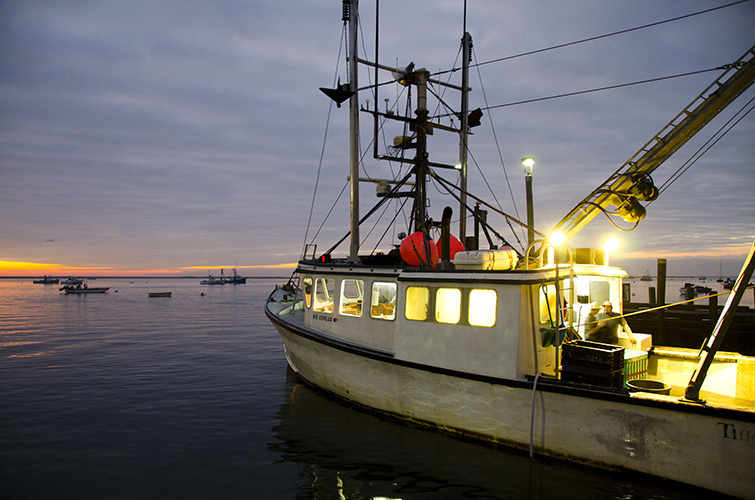NMFS will resume its usual at-sea observe coverage in the Northeast July 1, after a three-month hiatus when the agency waived requirements because of the covid-19 pandemic.
Dr. Jon Hare, science and research director for the Northeast Fisheries Science Center, confirmed Monday that the agency and its observer providers will move ahead with the resumption, in the planning stages since May 29.
“The Northeast Fisheries Science Center’s Fisheries Sampling Branch has been working through internal protocols and processes to ensure shoreside components of the program can operate,” Hare wrote in a letter to fishermen and other stakeholders. “They are also coordinating with observer providers to develop deployment plans that support the health and safety of observers, fishermen, and others in the fishing industry, in light of the covid-19 virus.”
But the Mid-Atlantic and New England fishery management councils reacted with dismay, reflecting worries in the industry that the observer program is being set back in motion before it is safe to do so.
“The council believes that deploying observers on fishing vessels at this time poses an unnecessary risk to the health and safety of fishermen and observers,” Mid-Atlantic council chairman Michael Luisi wrote in a June 23 letter to Hare and NMFS Northeast regional director Michael Pentony.
“We strongly recommend that you continue to extend the observer coverage waiver until the number of active covid-19 cases in the region has been substantially reduced and the number of new cases is steadily declining. This recommendation aligns with the council’s own developing position regarding in-person meetings, which prioritizes health and safety above all other concerns.”
NOAA employees are still operating under a “maximum telework” regime to minimize face-to-face contact, Luisi wrote, while much of the industry has moved toward 14-day quarantines for crew.
"Unless observers are subject to mandatory 14-day quarantine periods between assignments, we are concerned that they could unknowingly become vectors for transmission of the virus between fishing vessels," he wrote.
During their teleconferenced meeting Tuesday, members of the New England Fishery Management Council brought up the same worries to communicate by letter to NMFS leadership, asking for more details and transparency about safeguards. Fishing advocates in the online audience said resumption of at-sea observer trips is dreaded by many in the industry.
“We have grave concerns with this,” said Jackie Odell, executive director of the Northeast Seafood Coalition.
“If a captain or crew test positive, will they be required to not go fishing?” asked Ben Martens, executive director of the Maine Coast Fishermen’s Association.
In his letter to fishermen, Hare of the Northeast science center outlined what’s happening now.
“The Northeast Fisheries Science Center’s Fisheries Sampling Branch is developing a comprehensive plan for resuming operations that supports fishery monitoring, with safety at its core. This plan has to do with workplace operations, communications, people, training, and deployment of observers and monitors.
"This is some of what is included:"
• Beginning July 1, we will follow the sea day schedule and coverage targets laid out for the 2020 fishing year. Coverage targets are not expected to increase beyond those levels to make up for unused days during the waiver period.
• Vessels with Electronic Monitoring will temporarily not be assigned observers and monitors after the waiver lifts.
• To limit the number of different vessels an observer covers, we will temporarily lift restrictions on the number of times an observer/at-sea monitor can cover the same vessels.
• Observers and at-sea monitors will be deployed to vessels using the Pre-Trip Notification (PTNS), Scallop Vessel Call-in System (VCIC), and port intercepts (i.e., observers selecting trips for coverage in the ports).
Meanwhile, the agency is pressing observer providers to meet key requirements including:
• Training observers on covid-19 awareness and risk mitigation. • Deploying individuals to the same vessel(s) and ports as much as possible.
• Minimizing observer travel among vessels, ports, and states. • Pre-trip health screening for observers.
• 14-day self-isolation prior to first deployment.
• Personal protective equipment requirements.
• Temperature monitoring prior to and throughout deployment. • Protocols for detecting, reporting, and acting on COVID-19 symptoms at home and at sea.
• Vessel covid-19 assessment pre-screening questions.
NOAA is also preparing to bring crew back to the research vessel Bigelow and undertake its schedule of Northeast fisheries survey work through summer into the fall.
“We are also working to get the surveys on non-NOAA vessels back online – sea scallop, Northern shrimp, and surf clam,” according to Teri Frady, a spokeswoman for the science center. “Protocols for non-NOAA platforms are being developed on a case-by-case basis as each of these is operated by different organizations.”







